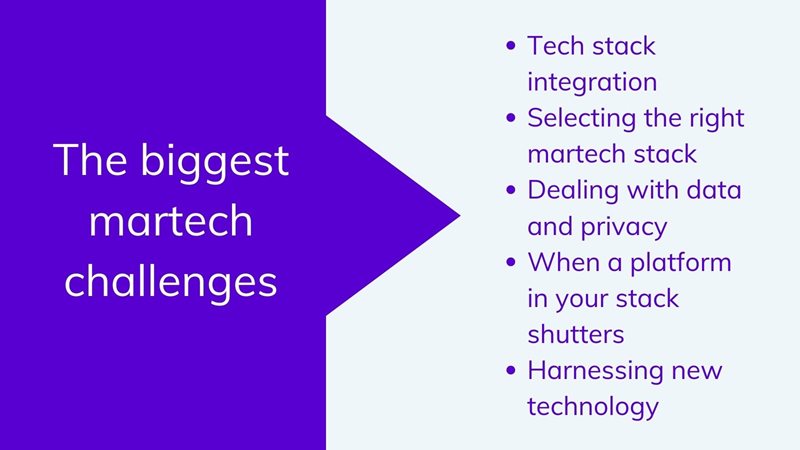A marketing technology stack – or martech stack – is a term that refers to a range of digital tools and platforms used to manage, execute, measure, and improve an organization’s marketing activities.
It’s an essential part of any marketing team’s toolkit – and that’s because identifying the right technologies and creating an efficient and streamlined stack can enable them to create better content workflows, simplify campaigns, collect and analyze data, and automate various tasks. In addition, a martech stack can be used to build relationships with users at different stages of their customer journey and across multiple digital channels.
But rather than adding a new marketing tool every few months, your budget will go further – and reap better results – if you adopt a strategic approach. To ensure your martech stack creates a seamless customer journey, meets your marketing goals, and gains efficiencies, it’s essential that the tools or platforms you select support the existing stack and speak to each in a logical and integrated way.
How to build a martech stack
Remember, the fundamentals of a successful stack are built around marketing automation, customer relationship management (CRM), a content management system (CMS), analytics software, and social media and search engine optimization (SEO) tools.
It will take some trial and error, but if you want to know how to build a martech stack, it’s helpful to keep these simple stages in mind:
- Define your marketing goals and the areas within your organization where you could benefit from digital tools and platforms.
- Carry out an audit to see what technologies you’re already using that can help perform these functions.
- Develop a list of needs and requirements to help you assess the various available technologies.
- Identify and implement your marketing technology solutions, providing training so staff can get the most from each tool and platform.
- As your organization grows – and your needs and requirements evolve – there’s every chance you’ll encounter one of these common marketing technology challenges. Read on to find out what they are and what you can do to ensure you overcome them and get the most out of your martech stack.
What are the biggest martech challenges?
A well-organized stack in sync with your organization is the end goal, but it can be too easy to fall into the trap of failing to integrate various tools and platforms or not adhering to robust data and privacy practices. Here are five challenges that can be avoided with the right strategy in place.
Tech stack integration
Marketing technology tools and platforms are intended to make life easier, but creating a stack without a clear strategy means you risk these tools and platforms working in silo. Marketing technology integrations save time, money, and resources, so make sure every element in your stack can communicate with each other.
Strive for integrations that support your workflow; in other words, tasks and actions should be triggered from one technology to the next without the need for manual intervention. As well as being workflow-driven, your integration also needs to be data-driven. This means the data is synchronized across multiple systems in real-time or at various intervals throughout the day – otherwise, you could end up with conflicting and confusing data that makes it difficult to judge the effectiveness of your marketing activities.
As you identify the solutions that will appear in your martech stack, ask yourself: do they have native applications that will do the integration for you, or do you need an integration platform as a service (IPaaS) to connect them? Once you know how the integration will be built, turn your attention to how the data will be shared and conduct internal tests to ensure the workflows perform as expected.
Selecting the right martech stack
We all want to take advantage of the latest technology, but by adding new tools and platforms when they are not truly necessary, you risk over-complicating your stack. After all, having multiple devices and platforms can make it difficult to manage relationships and integrations.
Marketing solutions set up incorrectly or measuring the wrong metrics aren’t getting you very far. And that’s why it’s so important to think of it as one whole system of technology rather than several separate tools.
As well as ensuring your marketing stack is fully integrated, you need to focus on ease of use – as this will help you save time and money on things like training and ensure your team is getting the most out of the technologies you selected. In addition, check that your stack allows you to segment your audiences, as the more personalized your marketing messages are, the better chance you’ll have of standing out in a crowded space.
When selecting, building, and optimizing your tech stack, establish exactly what tasks need to be accomplished rather than adding more tools in response to fresh challenges and as new platforms become available.
Dealing with data and privacy
Today’s customers want to know their personal information is protected, and due to various data regulations being rolled out in markets around the world, it’s never been more important to pay serious attention to privacy and demonstrate transparency and trustworthiness.
Map your existing stack and examine each technology’s data policy. Many of the best platforms and tools are distributed in a software as a service (SaaS) format and cloud storage, which come with various security challenges that you need to be aware of. In addition, when considering adding a new tool or platform to your stack, ensure the vendor is GDPR and CCDPA compliant and prioritize those with measures that go above and beyond existing legislation.
Similarly, if multiple users are handling the same accounts and using shared login details, you must regularly remove users who have left the organization, use two-factor authentication for access, and frequently change your passwords.
When a platform in your stack shutters
As discussed, an effective martech stack should be constructed in an integrated, workflow-driven, and data-driven way that enables you to offer an improved customer experience while performing several marketing functions, such as lead generation, email marketing, social media management, and search engine optimization.
That’s why, when one platform or tool ceases to exist, it can feel like the effectiveness of your stack hangs in the balance. But it doesn’t have to be this way. Before looking at the available marketing technologies, look inwards to understand if the platform or tool you are striving to replace is still necessary. Maybe another technology already in the stack can perform a similar function?
Similarly, use this challenge to see if you can select a tool or platform that does a similar job to the one that’s shuttered but maybe has additional functionality or more up-to-date features.
Harnessing new technology (and the skills required to use it)
A lot of the success of your martech stack relies on the buy-in of the teams using it. And with more and more channels becoming available for markets to reach, communicate with, and sell to their target audience, it’s essential to get to grips with the tools and platforms that support innovations like social, live, and mobile commerce – for example chatbots, email marketing, and instant messaging apps.
The intention is to make people’s lives easier, so introduce people to every platform and tool within the stack and ensure they have the skills to get the most out of them by investing in ongoing training. Similarly, regular check-ins will enable you to identify any problem areas.
In addition, involving the IT department in the development of your stack is essential – as it’s their technical skills that will be necessary to troubleshoot in both the short- and long-term and to ensure the efficient running of the stack.
Closing thoughts
As we’ve explored, ensuring your stack is working as effectively and efficiently as possible is one of the most common challenges marketers face. To adopt a ‘set and forget approach at your peril. Create a strategy from the outset, and keep examining and auditing the tools and platforms you’ve selected to ensure they fit your needs, integrate them, and create seamless user journeys while supporting your teams.






